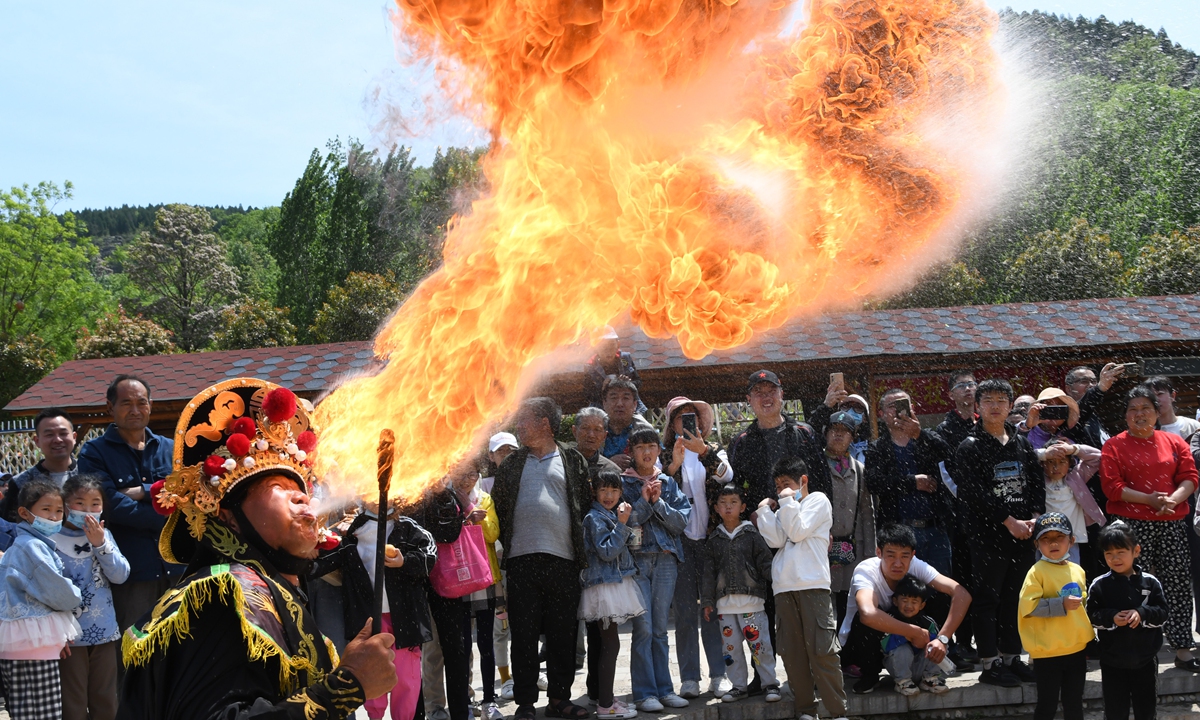
Music fans enjoy Midi Festival in Jinan, capital of East China's Shandong Province on May 2. Photo: IC
China has seen "hottest" holiday in the past few days since the COVID-19 pandemic happened, as tourism industry enjoyed overall prosperity during the five-day May Day holidays, showing China's achievements in tackling the pandemic and recovering the economy.
May Day, also known as the International Workers' Day, is observed on May 1. Many Chinese people have chosen to travel during the holiday that lasts from May 1 to 5 this year.
China Railway has estimated that the number of daily trips will reach 15.2 million, while 1,361 additional passenger trains will be put into service to meet surging demand.
On the third day of the holiday, the number of railway passengers in China exceeded the pre-pandemic levels - nearly 13.75 million passenger trips were made, a 3.2-percent increase over the same day in 2019.
Not only did the number of trips increase significantly compared with the same period last year, but industries such as tourist attractions and hotels also achieved record growth.
Some may have even grown exceedingly.
"I visited the Lama Temple in Beijing on May 3, only to see thousands of people queued up like a huge snake outside the entrance," Sun Xiao, a tourist from East China's Shandong Province, told the Global Times. "I returned my ticket that I had bought 10 minutes before and received a refund immediately, which was quite convenient."
Sun then spent 30 minutes waiting for a taxi. "It was crowded everywhere in Beijing's scenic spots. Several subway stations were closed due to the volume of tourists."Similar scenes were reported to have happened at many places around China, triggering people calling for better administration at attractions.
The prosperity of travel is closely related to the current domestic epidemic prevention and control achievements.
During the same period in the previous year, the country was still in recovery after the first wave of the epidemic, and many regions were still adopting stricter prevention measures to avoid outbreaks.
Now that most areas in the country have returned to normalcy, it has been possible for people to travel in the same way as before the epidemic. The only tiny difference might be that they need to show the "health code" from time to time.

gt
Boom of 'red tourism'
As this year marks the Communist Party of China's (CPC) 100th founding anniversary, this holiday also witnessed a recorded boom in "red tourism," which refers to people visiting historical sites to honor the revolutionary legacy.
At the Nanhu Lake in East China's Zhejiang Province, where the First National Congress of the CPC was held on a boat in 1921, young people are sending out postcards to share their feelings. In front of the Mao Zedong monument at the Orange Islet in Changsha, Central China's Hunan Province, many tourists are posing to take a picture at the best angel.
Among the core demographic of red tourism in this current holiday, people aged 21 to 30 accounted for more than 40 percent, the biggest group of all ages. Overall demographic under the age of 40 accounted for 89.1 percent.
Li Yu, a university student from Shanghai, traveled in Changsha during the holidays, and visiting the Orange Islet to take a selfie with the Mao Zedong monument was the highlight of her trip. She met a group of young students who posed as the number "100" to celebrate the CPC's century-long history.
"It's a very cool spot to take a photo," Li said. "Also, I heard that Mao's monument is facing the direction of the island of Taiwan, which is really touching to me."
Global Times

Tourists visit Hongya Cave, a landmark of Chongqing Municipality in Southwest China on May 3. Photo: IC

Tourists line up to view Buddha statues at Longmen Grottoes, Luoyang of Central China's Henan Province on May 3. The grottoes can be traced to the dynasty of Northern Wei (386-534). Photo: IC

People enjoy the tropical beach of Sanya, South China's Hainan Province during the May Day holidays. Photo: IC

An actor gives a fire breathing performance, a trick from the Sichuan Opera, in front of tourists at Hulutao village, East China's Shandong Province on May 2. Photo: IC

Tourists pose in front of the Yellow Crane Tower of Wuhan, Central China's Hubei Province, with specially-designed popsicles shaped exactly like the tower. Photo: IC

A man (right) receives a COVID-19 vaccine shot in a medical vehicle under the Saint Sophia Cathedral, a former Orthodox church and now a museum, in Harbin, capital of Northeast China's Heilongjiang on May 1. Photo: Li Hao/GT



